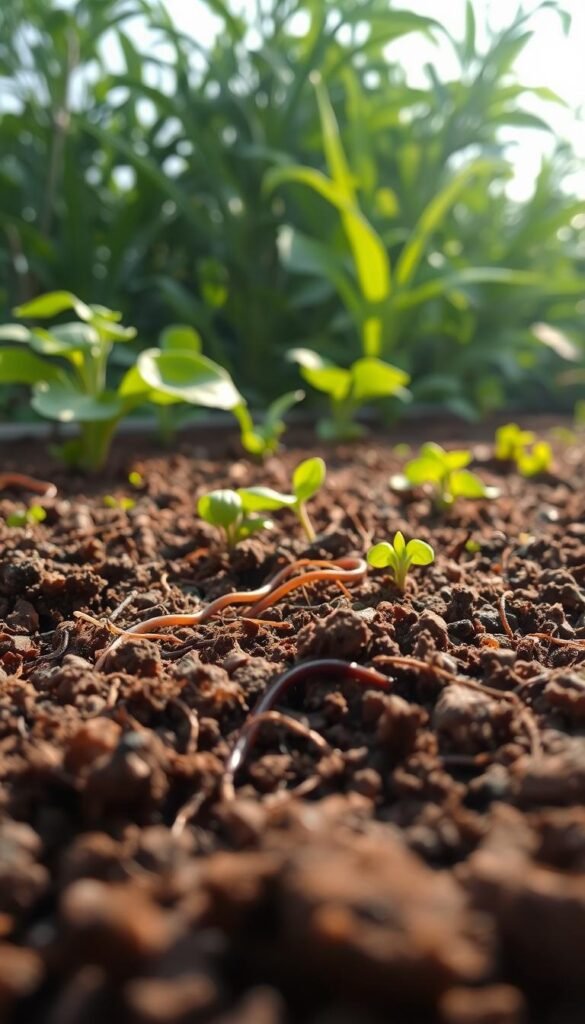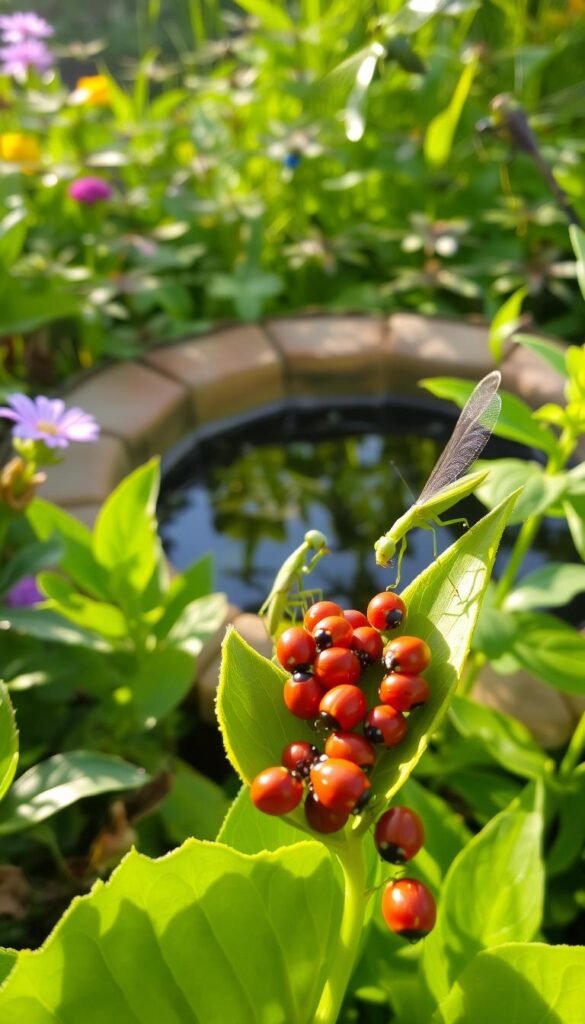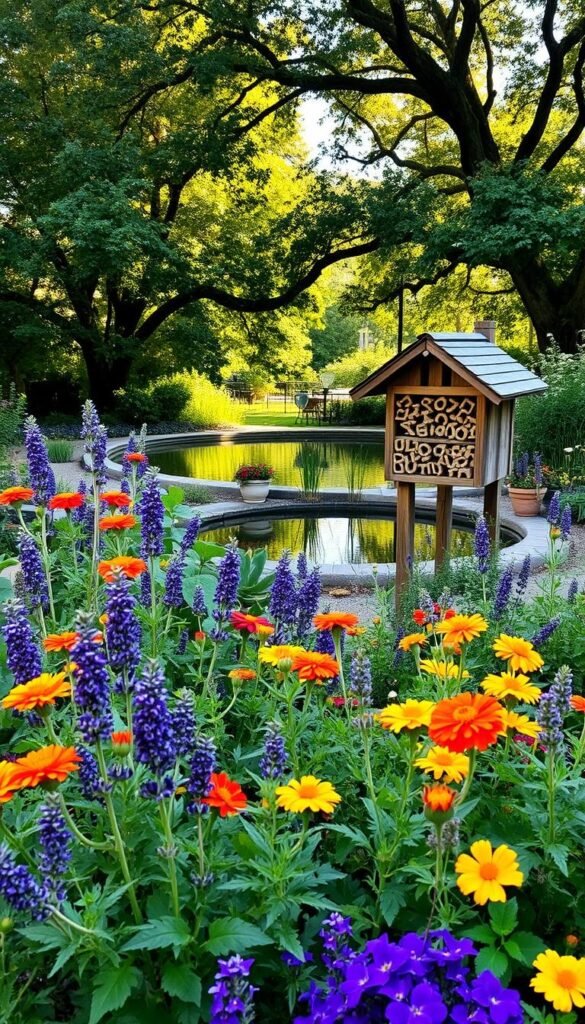Maintaining a healthy outdoor space means finding ways to protect your plants without harming the environment. Many gardeners are turning to nature-friendly methods to keep unwanted visitors away while supporting a balanced ecosystem.
Over time, these approaches have proven just as effective as harsh chemicals. They create long-term benefits like richer soil and stronger plant growth. You’ll also attract helpful creatures that keep problems in check naturally.
From simple homemade sprays to encouraging predator insects, there are plenty of options. Each method works with nature rather than against it. The results? A vibrant, chemical-free space that flourishes year after year.
Why Organic Pest Control Matters for Your Garden

Harmful chemicals might seem effective, but they disrupt nature’s delicate balance. Many synthetic sprays linger in soil and water, harming more than just unwanted insects. Over time, these choices impact your harvest, local wildlife, and even your family’s well-being.
The Risks of Chemical Pesticides
Homeowners often use three times more pesticides than farmers, contaminating groundwater and rivers. These toxins don’t just vanish—they cling to your tomatoes or kale, requiring thorough washing. “Wait, don’t eat that! We have to wash the poison off first!” is a phrase no gardener wants to repeat.
Synthetic sprays kill beneficial soil microbes and pollinators like bees. Without these helpers, plants struggle to grow strong. It can take three years for soil to recover after switching to natural methods.
Benefits of a Healthy Garden Ecosystem
Nature works best when left in balance. Healthy soil teeming with microbes grows pest-resistant plants, reducing infestations. Birds, ladybugs, and lacewings become your allies, controlling problems naturally.
Look for USDA Organic or OMRI-certified products to ensure safety. These options protect your garden’s health without sacrificing results. Over time, a thriving ecosystem means less work and more abundant harvests.
Prevention: The First Line of Defense Against Pests

A thriving garden starts with smart habits that discourage infestations naturally. By focusing on soil health, plant diversity, and cleanliness, you create an environment where problems struggle to take hold.
Build Healthy Soil With Compost and Mulch
Healthy soil grows resilient plants. Layer compost to boost nutrients and mulch to lock in moisture. Seaweed mulch adds iron and zinc while repelling slugs—a win-win for your greens.
Turn kitchen scraps into black gold. A balanced compost pile attracts worms and microbes, breaking down waste into rich fertilizer. Your plants will thank you with deeper roots and fewer issues.
Rotate Crops and Interplant Strategically
Pests love predictability. Break their cycle by rotating crops yearly—plant brassicas where legumes grew last season. This starves soil-dwelling larvae and prevents disease buildup.
Companion planting confuses invaders. Basil beside tomatoes deters aphids, while marigolds repel nematodes. Mixing heights and textures makes it harder for bugs to settle in.
Keep Foliage Dry and Gardens Tidy
Wet leaves invite fungus. Water at the base using drip irrigation, and prune dense foliage for airflow. A morning routine lets plants dry before nightfall.
Clean tools after handling sickly plants to avoid spreading trouble. Try the “chair method”—sit for five minutes daily to spot early warning signs like chewed edges or sticky residue.
Invite Pest Predators: Nature’s Pest Control Team

Your outdoor space can thrive when you welcome natural allies. Beneficial insects and animals keep unwanted visitors in check without chemicals. These predators work tirelessly, reducing the need for manual intervention.
Ladybugs for Aphids and Mites
Ladybugs are tiny warriors that devour over 50 aphids daily. Their larvae are even hungrier, targeting mites and soft-bodied pests. For quick results, release live ladybugs at dusk near infested plants.
Choose reputable suppliers like Arbico Organics for healthy specimens. Avoid spraying water for 24 hours after release—they’ll stick around longer. Plant dill or fennel to encourage them to stay.
Lacewings and Hover-Flies for Soft-Bodied Pests
Lacewings adore mealybugs, while their larvae tackle thrips. Attract them with nectar-rich flowers like yarrow or goldenrod. Hover-flies, often mistaken for bees, prefer cosmos and alyssum.
These beneficial insects multiply quickly in predator-friendly habitats. Gardens using this approach see 50% fewer outbreaks within two seasons. It’s a win for your plants and local ecosystems.
Encourage Birds and Snakes
Birds snack on caterpillars and beetles. Install birdhouses or a small water feature to invite them. Even wasps and spiders help—they hunt moths and smaller pests.
Garden snakes control slugs and rodents. Stack rocks or logs to create hiding spots. “They’re more scared of you than you are of them,” as seasoned gardeners say. Avoid harming non-venomous species.
For a bold solution, consider praying mantis egg cases. Mail-order options introduce these efficient hunters. They’ll patrol your space all season long.
Want more tips? Explore eco-friendly strategies for smaller spaces too. Nature’s team is ready to help—just give them a home.
Organic Pest Control Methods That Work
Simple, effective techniques can keep your plants thriving without synthetic sprays. These methods are both low-cost and kind to your garden’s ecosystem. Whether you’re battling beetles or nurturing delicate seedlings, nature provides answers.
Hand-Picking Pests (The “Chair Method”)
Grab a jar of soapy water and head out at dawn—when beetles are sluggish. Drop them into the jar for quick removal. *“Five minutes daily saves hours of damage,”* say seasoned growers.
Try the *“chair method”*: Sit quietly to spot chewed leaves or eggs. Early detection stops infestations before they spread. Bonus? Feed pests to chickens for extra protein—and eggs.
Beneficial Nematodes for Grubs and Beetles
Microscopic worms called nematodes hunt soil-dwelling pests like cutworms. They ignore earthworms, targeting only harmful larvae. Mix them with water and apply to damp soil for best results.
Milky spore powder is another hero. It kills Japanese beetle grubs for up to 40 years. Just sprinkle it once and let nature do the rest.
Diatomaceous Earth for Hard-Shelled Insects
This powder fossilizes hard-shelled insects on contact. Apply it with a dollar-store pantyhose for even coverage. Reapply after rain—it loses potency when wet.
Caution: Wear a mask to avoid inhaling the fine dust. For caterpillars, compare Spinosad (Captain Jack’s Deadbug) and B.T. (Bacillus thuringiensis). Both are safe for pollinators but target different pests.
Homemade Remedies for Common Garden Pests

Your kitchen holds powerful ingredients to protect plants naturally. These DIY solutions cost pennies and avoid harsh chemicals. Best of all, they’re gentle on your garden’s ecosystem.
Soap-and-Oil Spray for Aphids
Aphids hate this simple mix: 1 tablespoon canola oil and 1 teaspoon Castile soap in 1 quart water. Shake well and spray leaves every 3 days. *”Ivory soap works, but avoid Dawn—it harms soil microbes,”* warns Maryland Extension horticulturists.
For extra punch, add 5 drops peppermint oil. The soap breaks down pests’ outer layer, while oil smothers them. Rinse with water after 4 hours to protect delicate plants.
Garlic-Pepper Spray for Mites
Blend 2 cloves garlic, 1 cayenne pepper, and 1 quart water. Strain after 24 hours and add 1 teaspoon soap. This fiery spray repels spider mites and whiteflies.
Test on a few leaves first—some plants are sensitive. Reapply weekly, especially after rain. Store leftovers in a jar labeled *”Not for pasta!”*
Baking Soda Solution for Fungal Diseases
Powdery mildew vanishes with 2 tablespoons baking soda per gallon of water. Spray leaves every 7–10 days. For stubborn cases, try a 1:1 milk-water mix—the proteins create natural antifungals.
Compared to store-bought sprays like Mighty Mint, these recipes save up to $20 per season. Plus, they’re safe for kids, pets, and pollinators.
Using Neem Oil and Other Botanical Solutions

Nature offers powerful plant protectors when you know where to look. Botanical solutions like neem oil and essential oils provide a safe, effective way to manage unwanted visitors. These options work with your garden’s ecosystem, not against it.
How Cold-Pressed Neem Oil Repels Pests
Cold-pressed neem oil disrupts the life cycle of insects like flea beetles and aphids. It suppresses their appetite and breeding without harming beneficial bugs. Mix 1 tablespoon with 1 teaspoon Castile soap (like Dr. Bronner’s peppermint) per quart of water for a potent spray.
*“Neem’s compounds mimic insect hormones, confusing pests naturally,”* explains a USDA study. Reapply every 7–10 days, focusing on leaf undersides where insects hide.
Essential Oils as Natural Deterrents
Rosemary oil repels carrot flies, while citronella wards off mosquitoes. Both are gentler than synthetic sprays. For a DIY blend, add 10 drops of either to 2 cups water. Shake well before each use.
Avoid midday application—sunlight can scorch leaves. Apply at dusk when pollinators are less active. This protects bees while targeting pests.
When and How to Apply Botanical Sprays
Timing matters. Spray in the early morning or evening to prevent leaf burn. Always test on a few leaves first. OMRI-certified options like neem oil from Bonide ensure quality and safety.
- Store mixes in glass (plastic absorbs oils).
- Reapply after rain or heavy dew.
- Rotate oils to prevent pest resistance.
With these strategies, your plants stay protected—naturally.
Traps and Barriers: Non-Toxic Pest Management
Physical solutions offer a smart way to protect your plants without chemicals. These methods create simple yet effective defenses against unwanted visitors. They work by blocking access or capturing pests before they become a problem.
Yellow Sticky Traps for Flying Insects
Bright yellow boards coated with non-toxic glue catch whiteflies and fungus gnats. *”One trap per 25 square feet reduces infestations by 60%,”* notes a University of Minnesota study. For DIY versions, paint cardboard yellow and apply petroleum jelly.
Hang traps just above plants where flying insects hover. Replace when 75% covered. Avoid placing near flowers—you don’t want to trap pollinators.
Floating Row Covers to Protect Seedlings
Lightweight fabrics like Agribon shield young crops from beetles and moths. These covers let sunlight and water through while keeping pests out. Secure edges with soil or rocks to create a complete barrier.
Remove covers when plants flower to allow pollination. For squash vines, try floating row covers during the first few weeks—this blocks vine borers from laying eggs.
Cloches and Collars for Vulnerable Plants
Waxed cardboard collars prevent cabbage moths from reaching stems. Cut 4-inch circles with center slits, then slide around seedlings. Red sphere traps work similarly for apple maggots—hang one per 100 fruits.
- Repurpose milk jugs as cloches by cutting off bottoms
- Use copper tape to deter slugs—it gives them a mild shock
- Avoid permethrin—it lingers in soil for 90 days
Pheromone traps lure specific insects away from your bed. Place these at the garden’s edge to draw pests outward. *”Think of them as a distraction, not a solution,”* advises a Cornell horticulturist.
Dealing With Larger Pests: Deer, Rodents, and Moles
Not all garden invaders are tiny—some require stronger defenses. Deer, mice, and moles can cause significant damage overnight. Luckily, nature-friendly solutions keep them at bay without harsh chemicals.
Egg-Based Sprays to Deter Deer
Deer hate the smell of eggs. Mix 1 egg with ¼ cup water, shake well, and spray on plants. Reapply after rain to maintain protection.
For extra defense, try the *“human hair in cheesecloth”* hack. Hang sachets of hair around your garden’s perimeter. The scent mimics human presence, scaring away deer.
Peppermint Oil for Rodents
Mice avoid strong minty smells. Soak rags in peppermint oil and place near entry points. Refresh every two weeks as the scent fades.
Secure compost in tumblers to avoid attracting rodents with food scraps. Metal bins work best—they’re chew-proof and keep odors contained.
Soil Drainage Tips to Discourage Moles
Moles love damp soil. Improve drainage by mixing sand into clay-heavy areas. This makes tunnels harder to dig and less appealing.
- Install owl boxes to attract natural predators
- Use wire barriers around bulbs and roots
- Avoid overwatering—let the top inch of soil dry between waterings
With these strategies, you’ll protect your harvest from ground to foliage. Big or small, every pest has a natural solution.
Growing a Resilient Garden—Naturally
Nature rewards those who work with its rhythms, not against them. Over three years, healthy soil builds natural defenses, reducing pests and boosting plant health. Compost and mulch feed microbes, creating a thriving underground ecosystem.
Invite pollinators with bright calendula or nasturtiums. These flowers attract allies like bees and hoverflies. Observe your garden daily—spotting issues early means gentler fixes.
Diversity is key. Plant Umbelliferae (dill, fennel) to shelter beneficial insects. Your healthy garden becomes a balanced habitat where problems rarely spiral.
Your space thrives when nature collaborates! Start small, stay consistent, and let the garden teach you its rhythms.






